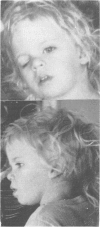Abstract
Retinoblastoma occurs with increased frequency in children born with a deletion of the long arm of chromosome 13. Recent reviews have noted that the region 13q14 is consistently deleted in documented cases. Prometaphase and late prophase banding allowed Yunis and Ramsay to determine that a deletion in one patient included the sub-bands q14 . 12, q14 . 13, and q14 . 2, and a portion of q14 . 11 and q14 . 3. We report the results of similar cytogenetic techniques applied in the case of a 26 month old Caucasian female with unilateral retinoblastoma, moderate developmental delay, and subtle dysmorphology. Prometaphase banding of cultured skin fibroblasts revealed the karyotype: mos46,XX/46,XX,del(13)(q13 . 1q14 . 11). Only the sub-band q14 . 11 is deleted in both our patient and that of Yunis and Ramsay. The results are consistent with the localisation of the retinoblastoma susceptibility gene(s) in the sub-band 13q14 . 11. Electrophoretic analysis and activity assays of red blood cell esterase D are consistent with hemizygous expression of that marker in our proband. Comparison with published esterase D analyses in families with retinoblastoma permits the assignment of the esterase D locus to that same sub-band, 13q14 . 11.
Full text
PDF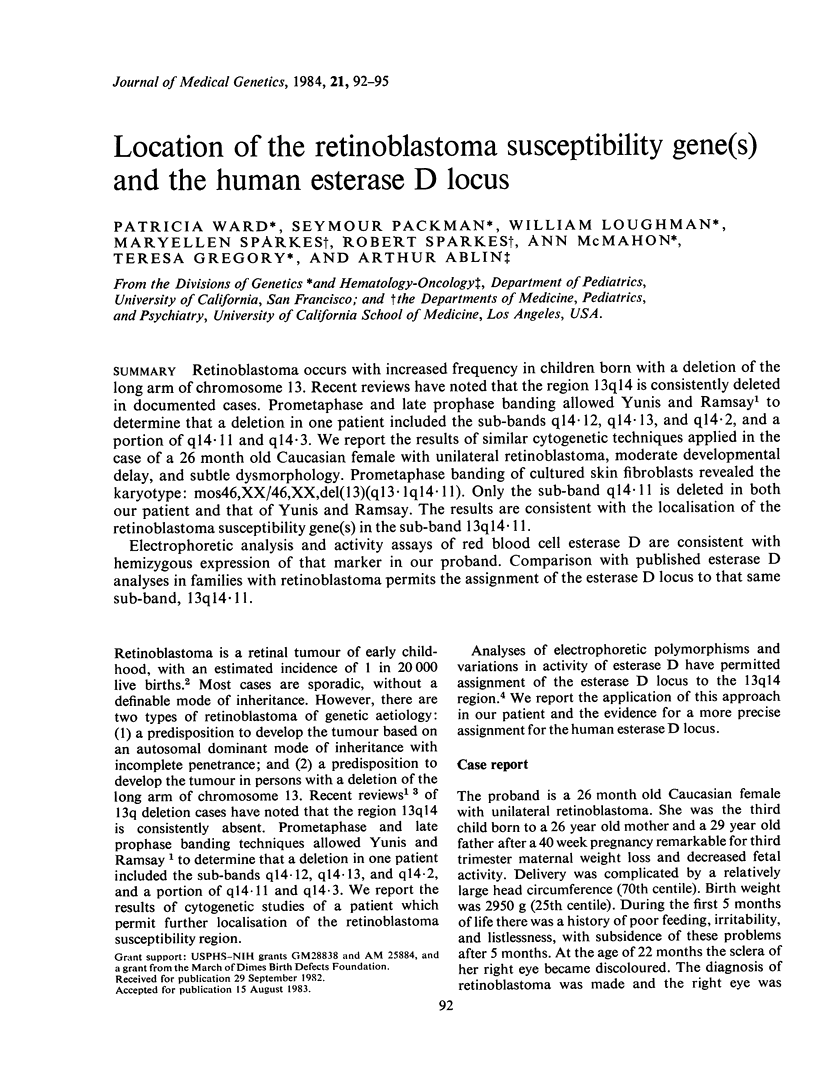
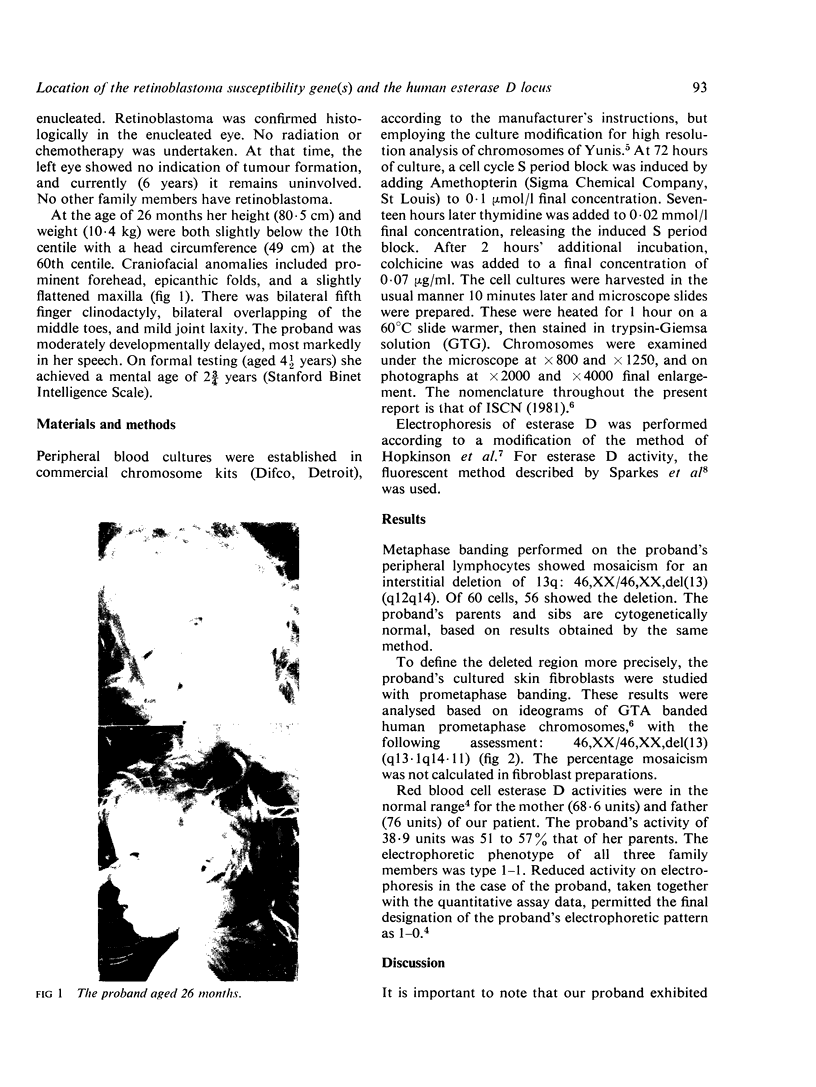
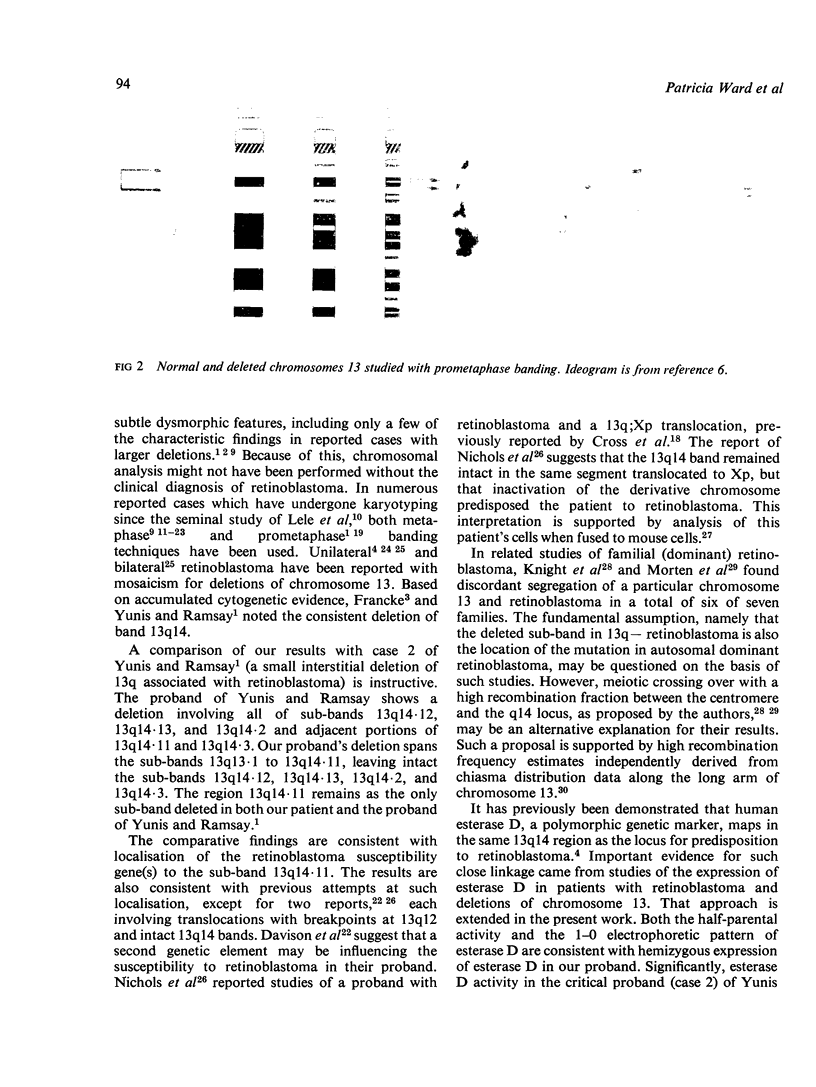
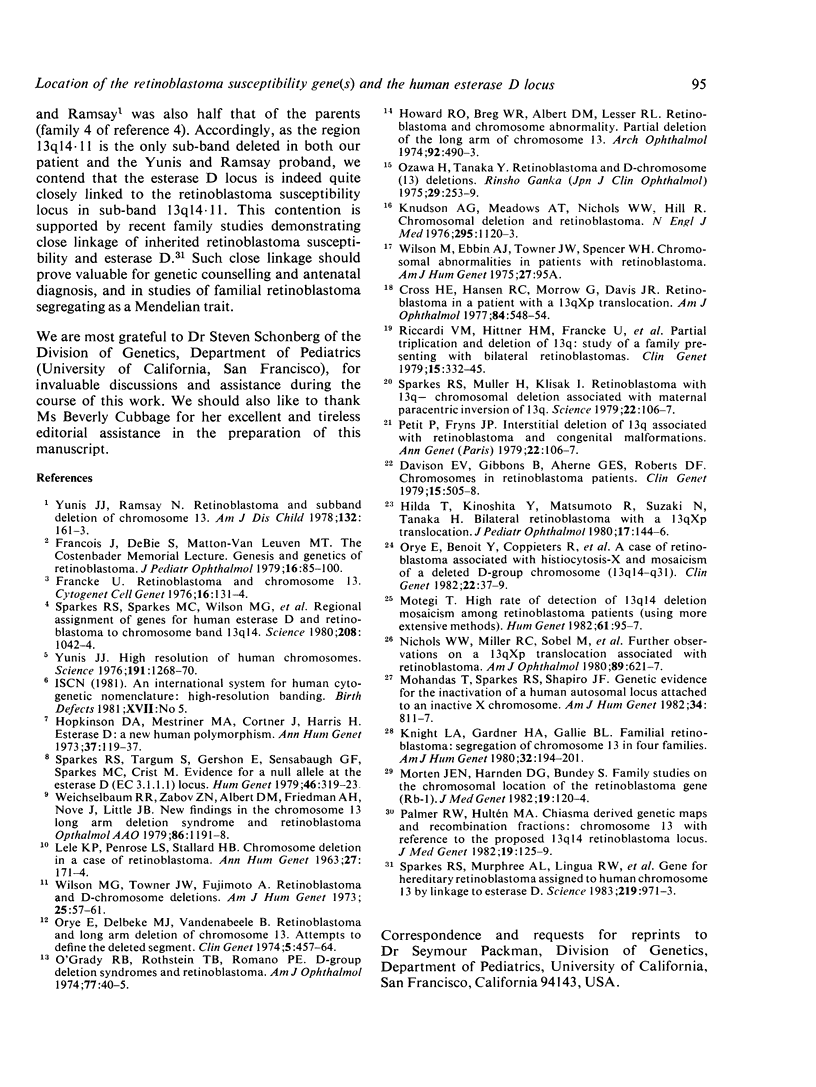
Images in this article
Selected References
These references are in PubMed. This may not be the complete list of references from this article.
- Cross H. E., Hansen R. C., Morrow G., 3rd, Davis J. R. Retinoblastoma in a patient with a 13qXp translocation. Am J Ophthalmol. 1977 Oct;84(4):548–554. doi: 10.1016/0002-9394(77)90450-0. [DOI] [PubMed] [Google Scholar]
- Davison E. V., Gibbons B., Aherne G. E., Roberts D. F. Chromosomes in retinoblastoma patients. Clin Genet. 1979 Jun;15(6):505–508. doi: 10.1111/j.1399-0004.1979.tb00833.x. [DOI] [PubMed] [Google Scholar]
- Francke U. Retinoblastoma and chromosome 13. Cytogenet Cell Genet. 1976;16(1-5):131–134. doi: 10.1159/000130573. [DOI] [PubMed] [Google Scholar]
- François J., DeBie S., Leuven M. T. The Costenbader Memorial Lecture. Genesis and genetics of retinoblastoma. J Pediatr Ophthalmol Strabismus. 1979 Mar-Apr;16(2):85–100. doi: 10.3928/0191-3913-19790301-03. [DOI] [PubMed] [Google Scholar]
- Hida T., Kinoshita Y., Matsumoto R., Suzuki N., Tanaka H. Bilateral retinoblastoma with a 13qXp translocation. J Pediatr Ophthalmol Strabismus. 1980 May-Jun;17(3):144–146. doi: 10.3928/0191-3913-19800501-04. [DOI] [PubMed] [Google Scholar]
- Hopkinson D. A., Mestriner M. A., Cortner J., Harris H. Esterase D: a new human polymorphism. Ann Hum Genet. 1973 Oct;37(2):119–137. doi: 10.1111/j.1469-1809.1973.tb01820.x. [DOI] [PubMed] [Google Scholar]
- Howard R. O., Breg W. R., Albert D. M., Lesser R. L. Retinoblastoma and chromosome abnormality. Partial deletion of the long arm of chromosome 13. Arch Ophthalmol. 1974 Dec;92(6):490–493. doi: 10.1001/archopht.1974.01010010504007. [DOI] [PubMed] [Google Scholar]
- Knight L. A., Gardner H. A., Gallie B. L. Familial retinoblastoma: segregation of chromosome 13 in four families. Am J Hum Genet. 1980 Mar;32(2):194–201. [PMC free article] [PubMed] [Google Scholar]
- LELE K. P., PENROSE L. S., STALLARD H. B. CHROMOSOME DELETION IN A CASE OF RETINOBLASTOMA. Ann Hum Genet. 1963 Nov;27:171–174. doi: 10.1111/j.1469-1809.1963.tb00209.x. [DOI] [PubMed] [Google Scholar]
- Mohandas T., Sparkes R. S., Shapiro L. J. Genetic evidence for the inactivation of a human autosomal locus attached to an inactive X chromosome. Am J Hum Genet. 1982 Sep;34(5):811–817. [PMC free article] [PubMed] [Google Scholar]
- Morten J., Harnden D. G., Bundey S. Family studies on the chromosomal location of the retinoblastoma gene (Rb-1). J Med Genet. 1982 Apr;19(2):120–124. doi: 10.1136/jmg.19.2.120. [DOI] [PMC free article] [PubMed] [Google Scholar]
- Motegi T. High rate of detection of 13q14 deletion mosaicism among retinoblastoma patients (using more extensive methods). Hum Genet. 1982;61(2):95–97. doi: 10.1007/BF00274194. [DOI] [PubMed] [Google Scholar]
- Nichols W. W., Miller R. C., Sobel M., Hoffman E., Sparkes R. S., Mohandas T., Veomett I., Davis J. R. Further observations on a 13qXp translocation associated with retinoblastoma. Am J Ophthalmol. 1980 May;89(5):621–627. doi: 10.1016/0002-9394(80)90276-7. [DOI] [PubMed] [Google Scholar]
- O'Grady R. B., Rothstein T. B., Romano P. E. D-group deletion syndromes and retinoblastoma. Am J Ophthalmol. 1974 Jan;77(1):40–45. doi: 10.1016/0002-9394(74)90602-3. [DOI] [PubMed] [Google Scholar]
- Orye E., Benoit Y., Coppieters R., Jeannin P., Vercruysse C., Delaey J., Delbeke M. J. A case of retinoblastoma, associated with histiocytosis-X and mosaicism of a deleted D-group chromosome (13q14 leads to q31). Clin Genet. 1982 Jul;22(1):37–39. [PubMed] [Google Scholar]
- Orye E., Delbeke M. J., Vandenabeele B. Retinoblastoma and long arm delection of chromosome 13. Attempts to define the deleted segment. Clin Genet. 1974;5(5):457–464. doi: 10.1111/j.1399-0004.1974.tb01719.x. [DOI] [PubMed] [Google Scholar]
- Palmer R. W., Hultén M. A. Chiasma derived genetic maps and recombination fractions: chromosome 13 with reference to the proposed 13q14 retinoblastoma locus. J Med Genet. 1982 Apr;19(2):125–129. doi: 10.1136/jmg.19.2.125. [DOI] [PMC free article] [PubMed] [Google Scholar]
- Petit P., Fryns J. P. Interstital deletion of 13q associated with retinoblastoma and congenital malformations. Ann Genet. 1979 Jun;22(2):106–107. [PubMed] [Google Scholar]
- Riccardi V. M., Hittner H. M., Francke U., Pippin S., Holmquist G. P., Kretzer F. L., Ferrell R. Partial triplication and deletion of 13q: study of a family presenting with bilateral retinoblastomas. Clin Genet. 1979 Apr;15(4):332–345. doi: 10.1111/j.1399-0004.1979.tb01743.x. [DOI] [PubMed] [Google Scholar]
- Sparkes R. S., Murphree A. L., Lingua R. W., Sparkes M. C., Field L. L., Funderburk S. J., Benedict W. F. Gene for hereditary retinoblastoma assigned to human chromosome 13 by linkage to esterase D. Science. 1983 Feb 25;219(4587):971–973. doi: 10.1126/science.6823558. [DOI] [PubMed] [Google Scholar]
- Sparkes R. S., Sparkes M. C., Wilson M. G., Towner J. W., Benedict W., Murphree A. L., Yunis J. J. Regional assignment of genes for human esterase D and retinoblastoma to chromosome band 13q14. Science. 1980 May 30;208(4447):1042–1044. doi: 10.1126/science.7375916. [DOI] [PubMed] [Google Scholar]
- Sparkes R. S., Targum S., Gershon E., Sensabaugh G. F., Sparkes M. C., Crist M. Evidence for a null allele at the esterase D (EC 3.1.1.1) locus. Hum Genet. 1979 Feb 15;46(3):319–323. doi: 10.1007/BF00273315. [DOI] [PubMed] [Google Scholar]
- Wackers F. J., Sokole E. B., Samson G., Schoot J. B., Lie K. I., Liem K. L., Wellens H. J. Value and limitations of thallium-201 scintigraphy in the acute phase of myocardial infarction. N Engl J Med. 1976 Jul 1;295(1):1–5. doi: 10.1056/NEJM197607012950101. [DOI] [PubMed] [Google Scholar]
- Weichselbaum R. R., Zakov Z. N., Albert D. M., Friedman A. H., Nove J., Little J. B. New findings in the chromosome 13 long-arm deletion syndrome and retinoblastoma. Ophthalmology. 1979 Jun;86(6):1191–1201. doi: 10.1016/s0161-6420(79)35429-x. [DOI] [PubMed] [Google Scholar]
- Wilson M. G., Towner J. W., Fujimoto A. Retinoblastoma and D-chromosome deletions. Am J Hum Genet. 1973 Jan;25(1):57–61. [PMC free article] [PubMed] [Google Scholar]
- Yunis J. J. High resolution of human chromosomes. Science. 1976 Mar 26;191(4233):1268–1270. doi: 10.1126/science.1257746. [DOI] [PubMed] [Google Scholar]
- Yunis J. J., Ramsay N. Retinoblastoma and subband deletion of chromosome 13. Am J Dis Child. 1978 Feb;132(2):161–163. doi: 10.1001/archpedi.1978.02120270059012. [DOI] [PubMed] [Google Scholar]



